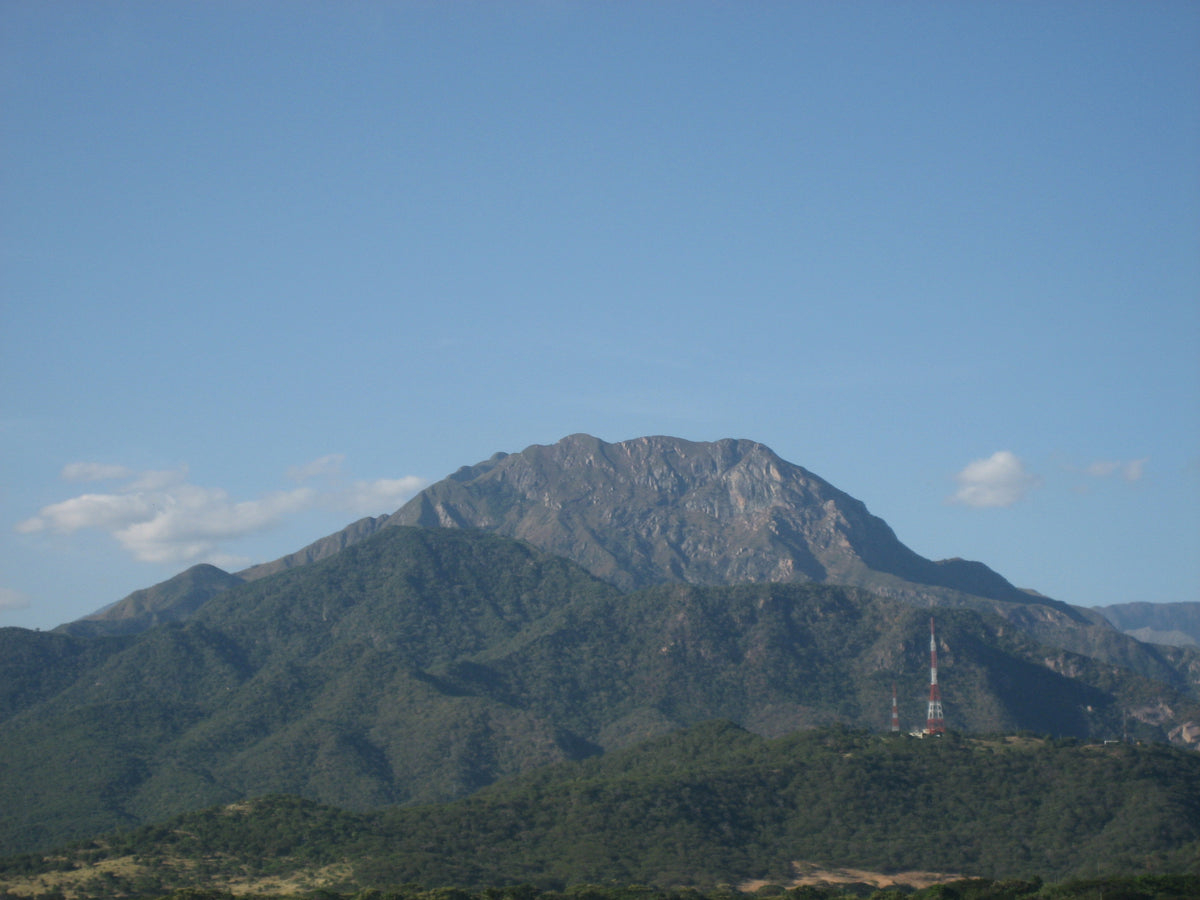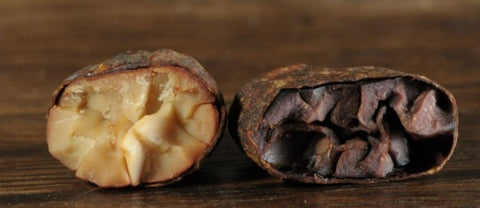
May 08, 2018
We recently received our first lot of an ancient origin cacao grown by the Arhuaco, one of four indigenous tribes that steward the pristine nature sanctuary of the Sierra Nevada de Santa Marta in Northern Colombia. These tribes are descended from the Tairona people, who retreated into this isolated volcanic region when the Spanish came to Colombia and colonized the coastal region.

Mamos - Spiritual Leaders of the Arhuaco - via Uncommon Cacao
Brian Wallace - Founder / Maker / Alchemist here at Endorfin Foods - first learned about the Arhuaco people years ago via his study of ethnobotany - the co-evolution of humans and plants (recommended viewing: The Worldwide Web of Belief and Ritual by Wade Davis). When we learned that Uncommon Cacao, one of our key supply chain partners in sourcing ethically traded cacao, was commencing trade with an Arhuaco community through an organization called Cacao de Colombia, we were the first chocolate maker in North America to pledge ourselves to working with this rare origin. The Arhuaco elders refuse to trade with anyone who they sense may upset the equilibrium of their communities and culture and only make decisions that they agree will be of benefit to their entire community, so the fact that they are willing to partner with Uncommon Cacao and Endorfin Foods in making a single origin dark chocolate bar and ceremonial cacao is a truly a privilege.

Cacao flower, sapling, and leaf.
Their cautious approach to outsiders is easy to understand when you hear their history. The Spanish forced the Tairona, the ancestors of the Arhuaco who had populated the coastal region of Colombia from at least the first century CE, high into the mountains when they colonized Colombia starting in 1499 CE. In 1916, groups of Capuchin friars set up missions near Arhuaco land, forcing adults into labor, and kidnapping many children to their missions, where they forced them to learn about Christianity, and forbade them from learn their own language and culture, further damaging their communities and spiritual and cultural wisdom traditions. In 1982, the Arhuaco peacefully expelled the Capuchins from their community. Missionaries of any type are no longer welcome.
Mamo Camilo offering a tour of their agroforestry based cacao farm - via Uncommon Cacao
In recent decades, Arhuaco territories have been traversed by all parties in Colombia’s violent internal conflicts and the international Drug War. In more recent years, paramilitary groups have appeared in the region, planting coca bush and opium poppy plantations, which have led the Colombian government to start spraying large swaths of forest with glyphosate and other toxic chemicals, further damaging their forests.The Arhuaco say that the Sierra Nevada de Santa Marta (in green on the map below), is the heart of the world and the origin point of all life, and that the well being of the rest of the world depends on its stability. It is surrounded by an invisible ‘black line’ that encompasses the 54 sacred sites of their ancestors.

The Arhuaco and their neighboring tribes call themselves the "elder brothers," and refer to those of us living in capitalist culture as "younger brothers". As our elder brothers, they believe it is their responsibility to maintain the balance and harmony of the universe by making pagamentos (offerings) to the 54 sacred sites in the black line, in order to give back to the earth what we extract from it. They pray for the planet and for us, their younger brothers, every day.
Pagamentos are primarily made by Mamo, spiritual leaders who are chosen between the ages of 8-10 and train for 9-15 years until they are considered ready to hold rituals, solve community legal issues and provide spiritual counseling.
“I, as a Mamo, represent all living beings… I dedicate myself to the preservation of Nature… I am made out of a very strong kind of wood so I am able to give support to all living beings within and outside of the Sierra. I care for millions and millions.” Mamo Zareymaku - Arhuaco leader.
The below video - made at the request of the Mamos - follows their journey to make offerings at sacred sites on their land
ANCIENT TAIRONA CACAO
The Arhuaco community is growing an ancient native species of cacao tree that was once cultivated by their Tairona ancestors. Native heirloom cacao trees grow wild in the coastal jungles here, which are widely believed to be one of the origin points of cacao. We know that the Tairona stewarded them using agroforestry, using their seeds and fruits as sacred medicines.
When the Spanish forced the Tairona from the coastal region, they lost access to these ancient trees. In recent years, the Colombian government has allowed the Arhuaco to purchase several thousand acres of their traditional coastal lands. But the Arhuaco weren't aware that cacao was part of their history until Mamo Camilo, the leader of one Arhuaco community, met with Carlos, one of the founders of Cacao de Colombia, who had been researching native Colombian cacao genetics foryears. Carlos told Mamo Camilo about the history of the Tairona growing cacao, and connected him with sources of native cacao genetics.
Mamo Camilo with a poporo - gourd and stick for sacred coca mixed with ground seashells. This traditional mix is one clue that the Arhuaco once occupied coastal regions of Colombia - via Uncommon Cacao
Recognizing that cacao growing is in their lineage, and that cacao naturally encourages forest growth in the jungle, Mamo Camilo's community began planting native cacao trees on their land. They are the first Arhuaco community to start growing cacao again after hundreds of years of colonization.
Mamo Camilo doesn't typically meet with strangers - it's very special that he is willing to meet with Cacao de Colombia and Uncommon Cacao staff, and it indicates that he trusts that this connection will not harm his community. Cacao de Colombia has set up a processing facility for the community, where fermentation and drying take place. This year, they handed that facility over to 3 Arhuaco brothers, who will process the cacao themselves and sell it to Cacao de Colombia for export. Through this dynamically transparent sourcing partnership, we are able to confirm that farmers are compensated at rates 62% higher than West African farmgate prices. We are honored to be able to purchase cacao from the Arhuaco, and are ecstatic that our sourcing efforts are economically beneficial to them in such a sustainable manner.
The native fine flavor Colombia cacao that they are growing has a higher prevalence of white cacao beans than most other origins. White cacao beans are rare, and are more commonly found in the fruit of genetically older cacao trees that are closer to their wild origin. White cacao beans get their color from their super high cocoa butter content. They give the Arhuaco cacao an extra rich smoothness that is lacking in the bitter compounds and anthocyanins typically found in most origins of cacao. This is why our ceremonial cacao crafted with beans from this origin has such a naturally pleasant flavor and intoxicatingly smooth mouthfeel.

White Cacao Bean aka "Cacao Blanco" vs. Traditional Cacao Bean
AGROFORESTRY - ANCIENT TECHNOLOGY THAT REGENERATES LAND
“In our conception the land gives permission to every plant that can be there, the only thing we have to do is to take care of the space. Nature itself will give what it has.” ~ Wilber, Arhuaco land steward
Like many indigenous peoples, the Arhuaco cultivate cacao and other crops using a regenerative agricultural practices we now call agroforestry, in which multiple food, medicine, and hardwood tree crops are grown together.

The Arhuaco primarily grow avocado, cedar, sapote fruit, and mataratón (a tree which produces food for livestock) as their canopy. Below these are shade loving midstory trees like cacao, plantain, and coca, and beneath these are medicinal and food crops such as yucca, corn, beans, and various tropical fruits. Their farmland is incredibly diverse and home to many animals, including armadillos, lowland pacas, squirrels, birds, and rodents.

"We still guard Nature in the Sierra, because everything was born here. Here is everything. The mamos are the keepers of nature and that is why the world still exists. The world is going out of balance because only a few Mamo are left. But we feel a need to rescue it, and we have enough energy to do it." - Mamo Seukukwi (Arhuaco Leader 94 years old)
Try our Single Origin 75% Cacao Dark Chocolate Bar produced from these rare single origin beans.
View currently available options for Ceremonial Cacao.
Comments will be approved before showing up.
February 05, 2021
December 16, 2020
Subscribe to the Slow Chocolate newsletter to get 10% off your next order from our website.
